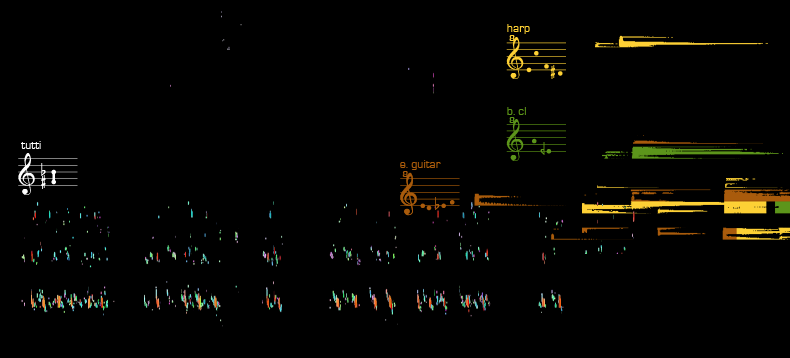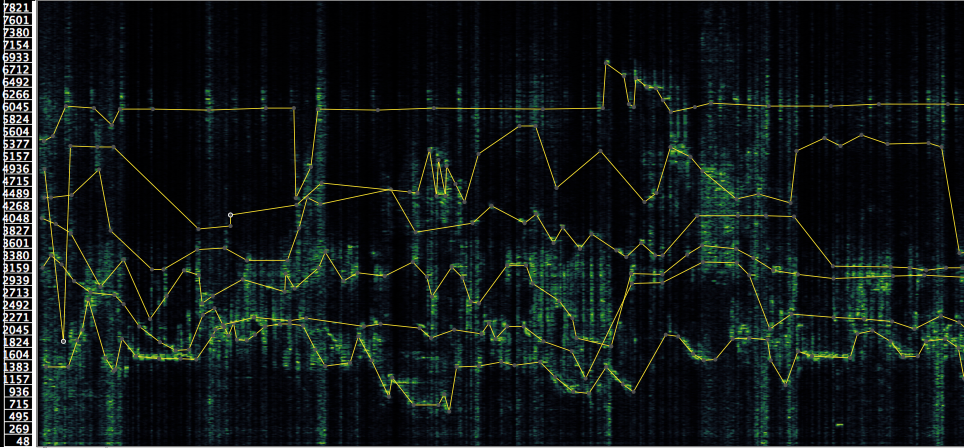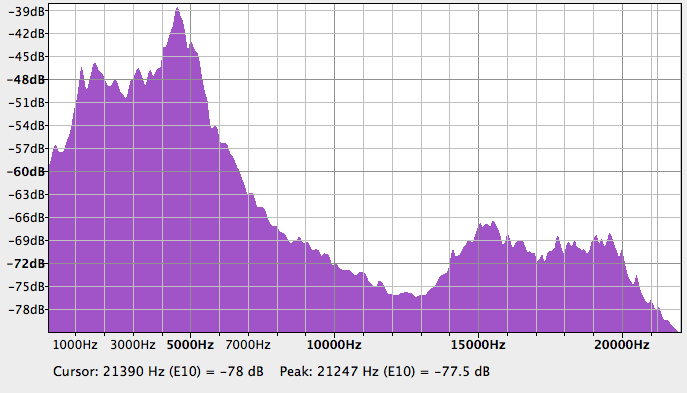| small waves raised by the evening combines components of the field recording of bullfrogs with spectrally frozen sections, using Eric Lyon’s thresher~ object to highlight amplitudinally prominent frequencies, with the source recording. Spatial depth was emulated by separating sonic features in different frequency bands into multiple channels with a series of frequency tracking patches developed by the composer in MaxMSP. As no actual spatial data was derived from the stereo field recording, the channels were then to spatialised according to their frequency (azimuth) and amplitude (distance) in the object ambipanning~. | Lindsay Vickery small waves raised by the evening [2016] (excerpt). |
A number approaches to frequency tracking were explored: manual frequency tracking, by annotating the spectrogram with multiple function objects and then retrieving the data by inputting the position of the audiofile as reported by snapshot~ to control the centre frequency of bandpass filters (Figure below); Automated frequency tracking controlling the bandpass filters’ centre frequency via frequencies derived from spectral anaylsis conducted using the sigmund~ object; and “ecological niche” tracking drawing on Krause’ theory which asserts that “animal and insect vocalisations tend to occupy small bands of frequencies leaving “spectral niches” (bands of little or no energy) into which the vocalisations (fundamental and formants) of other animals, birds or insects can fit.” (Wrightson, K. 2000. “Introduction to Acoustic Ecology”. Soundscape-The Journal of Acoustic Ecology, 1(1), pp. 10-13. p. 11).
Manual frequency tracking by annotating the spectrogram with multiple function objects to automate the centre frequency of bandpass filters.
| Audacity’s “Plot Spectrum” function. | This theory would suggest that band passing at particular frequencies will tend to capture divergent features of the sonic environment, Audacity’s Plot Spectrum function (Figure to the left) was used to determine the niche frequency bands in the recording and then bandpass filters were applied separately to each band. These frequency tracking processes are similar to conventional Audio Expansion, however the complexity and the uniform spread of amplitudes from increasingly distant sources that are common in most field recordings, render poor results from conventional expansion. |
Perhaps unsurprisingly then, the manual method for frequency tracking proved to be the most effective of those explored.
It could be argued that manual designation of the band pass frequencies adds a ‘human’ layer to the process in contradiction to the eco-structural aims of deriving all data from the environment itself. However, the process is no less of an intervention than choosing sonic features to be emulated by acoustic instruments and indeed, in this case, was achived through similar means: visual detection of features from a spectrogram. The approach is perhaps analogous to the ‘Cocktail Party Effect’ (Pollack, I. and J. Pickett. 1957. “Cocktail Party Effect”. Journal of the Acoustical Society of America 29 p. 1262) a feature of the human auditory perception in which conscious auditory attention allows for pre-semantic attenuation of signals in a complex environment.
It could be argued that manual designation of the band pass frequencies adds a ‘human’ layer to the process in contradiction to the eco-structural aims of deriving all data from the environment itself. However, the process is no less of an intervention than choosing sonic features to be emulated by acoustic instruments and indeed, in this case, was achived through similar means: visual detection of features from a spectrogram. The approach is perhaps analogous to the ‘Cocktail Party Effect’ (Pollack, I. and J. Pickett. 1957. “Cocktail Party Effect”. Journal of the Acoustical Society of America 29 p. 1262) a feature of the human auditory perception in which conscious auditory attention allows for pre-semantic attenuation of signals in a complex environment.




 RSS Feed
RSS Feed
